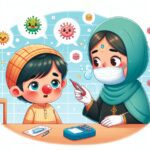One of the significant breastfeeding challenges many new mothers face is Mastitis, a condition that can make breastfeeding painful and stressful. Understanding Mastitis symptoms and treatments is crucial for managing and overcoming this hurdle, ensuring both mother and baby continue to enjoy the benefits of breastfeeding. This comprehensive guide delves into what Mastitis is, its symptoms, various treatment options, and ways to prevent it from recurring.
Understanding Mastitis: A Common Breastfeeding Challenge
Mastitis is an inflammation of the breast tissue that often involves an infection. The condition can occur when milk is not properly removed from the breast, leading to a buildup that infects the tissue. It’s a common issue among breastfeeding mothers but can also affect women who are not breastfeeding. Symptoms of Mastitis include breast tenderness, swelling, redness, fever, and flu-like symptoms.
Several factors can contribute to the development of Mastitis, including blocked milk ducts, bacteria entering the breast, and overproduction of milk. To understand more about the causes and to discover effective strategies for prevention, refer to our detailed guide on Breastfeeding challenges: Mastitis symptoms and treatments.
Breastfeeding challenges: Mastitis symptoms and treatments
Identifying the symptoms of Mastitis early on is essential for prompt treatment and relief. The most common symptoms include intense pain or tenderness in one area of the breast, redness or swelling, a lump in the breast, fever, and chills. It is vital to seek medical advice if you suspect you have Mastitis to prevent complications and ensure a swift recovery.
Treatment for Mastitis often involves antibiotics to clear the infection, pain relief medications, and continued breastfeeding or pumping to ensure milk removal. Applying warm compresses to the affected area and ensuring proper breastfeeding techniques can also alleviate symptoms. For detailed treatment options and ways to manage pain, see our article on dealing with diaper rashes: prevention and treatment, which outlines similar approaches for managing discomfort and promoting healing.
Preventing Mastitis for a Smoother Breastfeeding Journey
To prevent Mastitis, it’s important to ensure proper breastfeeding techniques, frequent nursing to avoid milk buildup, and attentive breast care. Keeping the nipples clean and dry, changing breast pads frequently, and wearing a properly fitting bra can also reduce the risk of developing Mastitis. Regularly emptying the breasts and switching positions during breastfeeding can help prevent blocked ducts, a common precursor to Mastitis.
Beyond these measures, paying close attention to your body’s signals and seeking prompt treatment for any initial signs of Mastitis is vital. For more tips on navigating common breastfeeding challenges and ensuring the well-being of both mother and baby, explore our resources on safe sleep practices to reduce the risk of SIDS, preventing choking hazards: safe foods for infants and toddlers, and recognizing signs of food allergies in infants.













